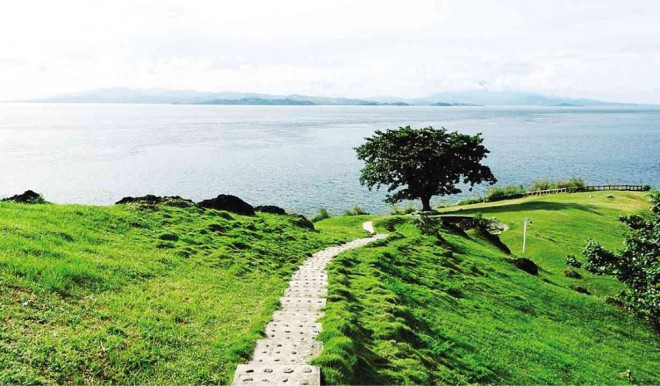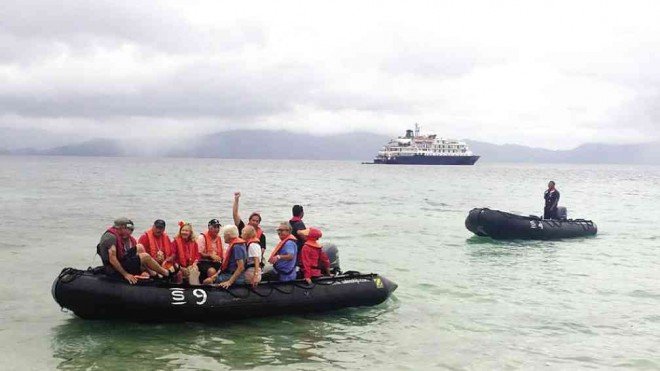Islets charm foreigners on cruise ship

The clear waters, beaches and people of Capul Island in Northern Samar have awed foreign tourists during their brief stop in February. COURTESY OF DOT REGION VIII
Two islets rich in history and cultural heritage captivated the hearts of foreign tourists on a cruise ship during stopovers in the Visayas last month.
“They loved their activities, enjoyed the rustic ambiance of the place and, most significantly, were charmed by the warmth and friendliness of the entire community,” said Karen S. Tiopes, Department of Tourism director for Eastern Visayas.
The 87 Americans, Europeans and some Asians, as well as their guides, on board the MS Caledonian Sky, had their taste of the world-renowned Filipino hospitality on Capul Island in Northern Samar province and on Limasawa Island in Southern Leyte province. They realized what the slogan “It’s more fun in the Philippines” means.
For both excursions, the tourists stayed for 10 hours on each island as part of the 21-day Philippine expedition under Zegrahm Expeditions. The tour, handled by Sharp Travel Service, embarked in Sandakan, Malaysia, on Feb. 7 and ended in Davao City.
On Feb. 18, the 4,200-ton Caledonian Sky reached Capul, one of the oldest municipalities in the country, along the San Bernardino Strait. Some 15,000 islanders speak the Inabaknon, a unique indigenous language which traces its roots to King Abak of Java, Malaysia, who set foot on the island during the 13th century.
Article continues after this advertisementDances and native songs greeted the visitors at the fortress church of St. Ignatius de Loyola, a 400-year-old stone church declared a historical site by the National Heritage Commission of the Philippines in 2011.
Article continues after this advertisementAt the historic Faro de Capul (lighthouse), they were awed by the scenic view and learned about the island’s past from local guides.
A short walk ended at the bañadero (community laundry area by the spring), where women washing clothes were singing. One of the male tourists gamely washed his shirt, using the palo-palo (wooden paddle).
At a coconut farm, the guests saw how copra was made—from harvesting to drying and transport—and how home products, such as broomsticks, baskets, roof shingles, baskets and charcoal, were crafted out of coconut parts. Moreover, they learned how delicacies using coconut milk and meat were cooked. They even bought some to take home.
One guest climbed a coconut tree and rode on a kangga, a bamboo-and-wood sled pulled by a carabao. Some even dared to ride on the habal-habal motorcycle, the mode of transport on the island.
Mayor Isidro Suan Bandal said it was the first time that a cruise ship visited Capul.
On Feb. 23, the foreigners set foot on Limasawa, the youngest municipality of Southern Leyte with a population of 6,500, where the first Mass in the Philippine archipelago was held. They visited the Limasawa Shrine and learned to write their names in ancient Baybayin.
They had their share of henna tattoos with the intricate designs of the “Pintados,” as what the natives were called by the early Spanish colonizers.
Like in Capul, the tourists interacted with the locals whom they found to be warm and friendly.
They watched the operetta (a short version of an opera) of Rajah Kulambo, the chieftain when the first Mass in the archipelago was held 494 years ago, and his five wives. (Limasawa was coined from lima, meaning five, and misua, wives.)
The biggest excursion in the expedition “was like a town fiesta with kakanin (native delicacies) complete with lechon (roasted pig), a culinary feast that the foreigners enjoyed to the hilt,” Mayor Melchor Petracorta said.
While some tourists—divers, geologists and bird-watchers—were diving in the clear waters of the Sogod Bay near Limasawa, the whale sharks showed up.
“Even the whale sharks were cooperating,” Tiopes said in the vernacular.
